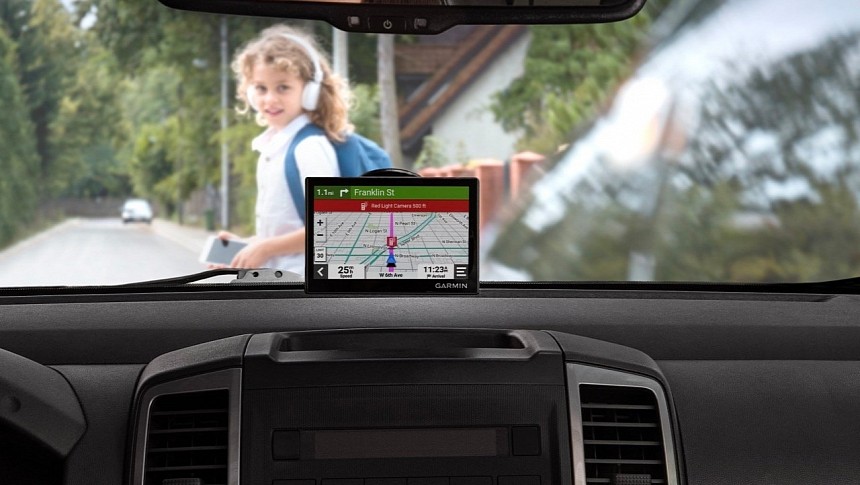You’d think Google Maps and Waze have pretty much killed off the traditional GPS navigator, but Garmin is here to prove you otherwise.
The company has just unveiled two new navigation units as part of its Garmin Drive product line. Their purpose is as simple as it could be: provide route guidance to the driver without draining the mobile phone’s battery.
In other words, Garmin hopes its new devices will eat up Google Maps’ share in the navigation software world. Of course, whether or not this would work comes down to many factors, but Garmin has tried to take care of almost everything.
Garmin Drive 53 and Garmin Drive 53 & Traffic are two models specifically focused on navigation. They come with a 5.0-inch touchscreen with a resolution of 800x480 pixels. Sure enough, these specifications could disappoint some customers, especially because a mobile phone typically has a better-quality screen and bigger resolution.
Garmin believes its exclusive navigation focus would convince users to jump ship. As such, the device packs the typical turn-by-turn route guidance and a large collection of Points of Interest. The parent company promises frequent updates for North American users, so presumably, these devices aren’t necessarily aimed at European drivers.
The “Traffic” version of the new navigators includes a vehicle power cable with a traffic antenna. Garmin says the device would pull dynamic data to provide alerts (most likely, similar to Waze) and alternative routes depending on traffic conditions.
The standard model is just there to offer standard navigation from point A to point B, with just a series of extras. For instance, it includes TripAdvisor traveler ratings to help you find restaurants and hotels and a directory of U.S. national parks (again, this proves the two devices are primarily aimed at the NA market).
Sure enough, such navigators can’t be expensive. Garmin Drive can be yours for $149.99, while the Waze rival costs $169.99. Both are already available from Garmin stores.
Will Garmin’s devices convince Google Maps users to jump ship? Probably not, especially because they hardly provide any benefits as compared to a mobile navigation app.
Their hardware specifications are modest, to say the least, and given the basic navigation, it’s impossible to see them as Google Maps or Waze killers. Garmin’s main selling point appears to be the shortcomings of running navigation on a mobile device. The company says a GPS navigator wouldn’t drain the phone battery or suffer from phone call interruptions.
For the sake of comparison, Google Maps also supports offline maps, so it can navigate without an Internet connection. And just like Garmin’s GPS navigators, a mobile phone can also charge while driving, so the battery drain isn’t a problem unless you want to use it for marketing purposes.
In other words, Garmin hopes its new devices will eat up Google Maps’ share in the navigation software world. Of course, whether or not this would work comes down to many factors, but Garmin has tried to take care of almost everything.
Garmin Drive 53 and Garmin Drive 53 & Traffic are two models specifically focused on navigation. They come with a 5.0-inch touchscreen with a resolution of 800x480 pixels. Sure enough, these specifications could disappoint some customers, especially because a mobile phone typically has a better-quality screen and bigger resolution.
Garmin believes its exclusive navigation focus would convince users to jump ship. As such, the device packs the typical turn-by-turn route guidance and a large collection of Points of Interest. The parent company promises frequent updates for North American users, so presumably, these devices aren’t necessarily aimed at European drivers.
The “Traffic” version of the new navigators includes a vehicle power cable with a traffic antenna. Garmin says the device would pull dynamic data to provide alerts (most likely, similar to Waze) and alternative routes depending on traffic conditions.
The standard model is just there to offer standard navigation from point A to point B, with just a series of extras. For instance, it includes TripAdvisor traveler ratings to help you find restaurants and hotels and a directory of U.S. national parks (again, this proves the two devices are primarily aimed at the NA market).
Sure enough, such navigators can’t be expensive. Garmin Drive can be yours for $149.99, while the Waze rival costs $169.99. Both are already available from Garmin stores.
Will Garmin’s devices convince Google Maps users to jump ship? Probably not, especially because they hardly provide any benefits as compared to a mobile navigation app.
Their hardware specifications are modest, to say the least, and given the basic navigation, it’s impossible to see them as Google Maps or Waze killers. Garmin’s main selling point appears to be the shortcomings of running navigation on a mobile device. The company says a GPS navigator wouldn’t drain the phone battery or suffer from phone call interruptions.
For the sake of comparison, Google Maps also supports offline maps, so it can navigate without an Internet connection. And just like Garmin’s GPS navigators, a mobile phone can also charge while driving, so the battery drain isn’t a problem unless you want to use it for marketing purposes.







